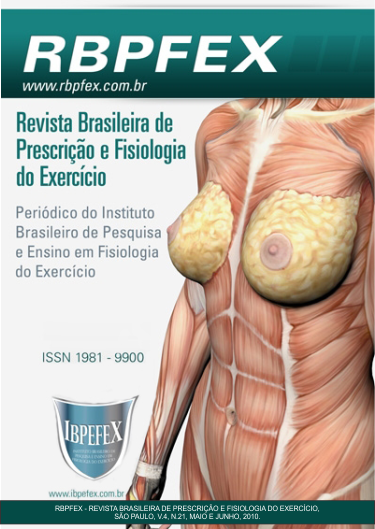Influence of contractions perinea’s associates the physical exercises in the whitewashing de patient with effort incontinence urinary: a case study
Abstract
The stress urinary incontinence (SUI) is defined as involuntary loss of urine, when the intra vesicle pressure exceeds that of urethra in the absence of contraction of detractor, that occur associated the abrupt increase of abdominal pressure as in the cough, sneeze,or physical activity. One of the alternatives of treatment for SUI is the pelvic floor muscle training through perinea’s contractions of Kegel, that has as purpose to adjust the pelvic floor muscles generating an increase of the force of closing and urethral sustentation, essential to obstruction the urinary loss in the moments stress. For this work it was selected a patient with complain and diagnosis of SUI confirmed through urodynamic study that was submitted to a protocol of physical exercises associates the perinea’s contractions in period of twelve weeks as the objective to evaluate the influence of the perinea’s contractions associates the physical exercises who simulated situation of urinary loss, in the rehabilitation of a patient with diagnosis of SUI . After the training the patient did not present more clinical complaint of SUI , with did not show the urinary loss in the urodynamic study, suggesting that the physical exercises associated the perinea’s contractions had been efficientin a program of pelvic floor muscles training for the rehabilitation of SUI light making substantial improvement or cure of the symptoms of IUE.
References
-International Continence Society. Comitee on Standadisation of Terminology. The Standadisation of Terminology of lower urinary tract fuction. In: Ostegard, R.; Bent, AE. editors. Urogynecology and Urodinamics: theory and practice. 3rd. Ed Baltimore: Williams & Wilkins. 1991 p. 545-62.
-Moreira, S.F.S.; e colaboradores. Mobilidade do colo vesical e avaliação funcional do assoalho pélvico em mulheres continentes e com Incontinência Urinaria de Esforço, consoante o estado hormonal. Revista Brasileira de Ginecologia e Obstetrícia. Vol. 24. Num. 6. 2002. p. 365-370.
-Bernardes, N.O.; e colaboradores. Métodos de tratamento utilizados na Incontinência urinaria de esforço genuína: um estudo comparativo. Revista Brasileira de Ginecologia e Obstetrícia. Vol. 22. Num. 1. 2000. p. 49-54.
-Rossi, P; Ribeiro, R.M. Avaliação do tratamento cirúrgico da incontinência urinária de esforço. Sinopse de Ginecologia e Obstetrícia. Num. 2. 2001.
-Carrerete, F.; e colaboradores. Incontinência urinaria de esforço. Revista Brasileira de Medicina. Vol. 56.(edição especial) Rio de Janeiro. Abril 99.
-Carrerete, F.; Damião, R. Incontinência urinária na mulher na visão da urologia. Revista Brasileira de Medicina. Vol. 56. Num. 11. 1999.
-Sampaio, F.B.; e colaboradores. Tratamento não cirúrgico da iIncontinência urinária de esforço na mulher, em I Consenso Brasileiro-Incontinência Urinária, Uroneurologia e Disfunções Miccionais, 1999.
-Grosse, D.; Sengler, J., Reeducação perineal –Concepção, realização e transcrição em prática liberal e hospitalar. 1º ed. Manole. São Paulo. 2002.
-Hanh, I.; e colaboradores. Comparative assessment of pelvic floor function using vaginal cones, vaginal digital palpation and vaginal pressure measurements. Gynecol Obstet Invest. Num. 41. 1996. p. 269-274.
-Bo, K.; Maanum, M. Does vaginal electrical stimulation cause pelvic floor muscle contraction? a pilot study. Scand J Urol Nephrol Suppl. Num. 179. 1996. p. 39-45.
-Holley, R.L.; e colaboradores. Long-term failure of pelvic floor musculature exercises in treatment of genuine stress incontinence. South Med J. Num. 88. 1995. p. 547-549.
-Lucas, M.; Emery,S.; Beynon, J. Incontinence 1º ed. Blackwell Science Ltd. France 1999.
-Robergs, R.A.; Roberts, S.O. Princípios fundamentais de Fisiologia do Exercício para Aptidão, Desempenho e Saúde. São Paulo. Phorte 2002.
-Neumann, P.; Gill, V. Pelvic floor and abdominal muscle interaction: emg activity and intra-abdominal pressure Int Urogynecol J. Australia. Num. 13. 2002. p. 125-132.
-Bo, K. Pelvic floor muscle exercise for treatment of stress urinary incontinence: an exercise physiology perspective. Int Urogynecol J. Num. 6. 1995.p. 282-291.
-Liao, Y.M; Dougherty, M.C.; Liou, Y.S.; Tseng, I.J. Pelvic floor muscle training effect on urinary incontinence knowledge, attitudes, and severity: an experimental study.Int J Nurs Stud. Vol. 43. Num. 1. 2006. p. 29-37.
-Kuo, H.C. Videourodynamic results in stress urinary incontinence patients after pelvic floor muscle training. J Formos Med Assoc. Vol. 102. Num. 01. 2003.
-Devillers, P.; Mauroy, B. Rééducation uro-gynécologique féminine. Techniques et indications. Prog Urol. Vol. 7. Num. 4. 1997. p. 83-93.
-Buzelin, J.M. Incontinence urinaire de la femme. Quel bilan? Quel traitement?. Ann Urol (Paris). Vol. 32. Num. 2. 1998. p. 83-88.
Authors who publish in this journal agree to the following terms:
- Authors retain the copyright and grant the journal the right of first publication, with work simultaneously licensed under the Creative Commons Attribution License BY-NC which allows the sharing of the work with acknowledgment of the authorship of the work and initial publication in this journal.
- Authors are authorized to enter into additional contracts separately for non-exclusive distribution of the version of the work published in this journal (eg, publishing in institutional repository or book chapter), with acknowledgment of authorship and initial publication in this journal.
- Authors are allowed and encouraged to post and distribute their work online (eg, in institutional repositories or on their personal page) at any point before or during the editorial process, as this can bring about productive change as well as increase impact and impact. citation of published work (See The Effect of Free Access).






